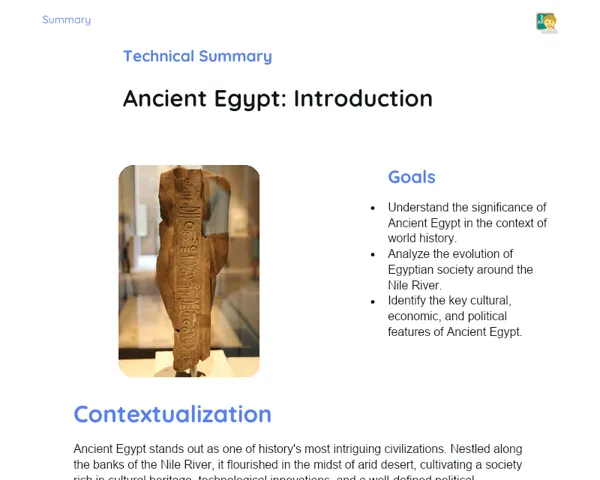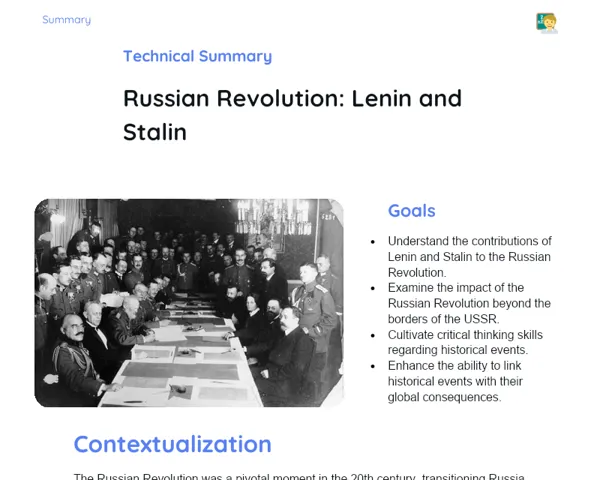Summary Tradisional | Absolutism
Contextualization
Absolutism was the dominant political system in Europe from the 16th to the 18th centuries. During this era, several nations like France, Spain, and even England were ruled by kings and queens who held unchecked power over their lands and people. These monarchs exercised centralized authority, making decisions on their own without frequently consulting parliaments or any representative bodies. Their absolute control was often defended by the concept of the Divine Right of Kings – a belief that their right to rule was directly granted by God, and thus any opposition was seen as challenging a divine order.
A classic example is King Louis XIV of France, famously known as the 'Sun King'. He built the splendid Palace of Versailles, which served both as his residence and as a grand symbol of the monarchy’s might and splendour. His legendary statement, 'L'État, c'est moi' ('I am the state'), encapsulates the core of absolutism, where all power was vested in a single ruler. Such instances help us understand how absolutism shaped the political and social framework of modern Europe.
To Remember!
Theories of Absolutism
Absolutism was often supported by theories that justified concentrating power in the hands of a monarch. The most well-known of these was the Divine Right of Kings. According to this belief, the authority of a king or queen was bestowed directly by God – making their rule unquestionable by subjects or any earthly institution. This idea was a potent tool, as any resistance to the monarch could be interpreted as a challenge against divine will.
In addition to the Divine Right, other political philosophies played their part. Thinkers like Jean Bodin and Thomas Hobbes stressed the importance of a strong central government to maintain order. Bodin argued that absolute sovereignty was crucial for civil peace, while Hobbes, in his work 'Leviathan', suggested that only an all-powerful sovereign could prevent the chaos and strife that he believed were inherent to human nature.
These theories not only reinforced the standing of monarchs but also bolstered public opinion that a centralized, absolute form of government was essential for the security and prosperity of a state.
-
The Divine Right of Kings claimed that a monarch’s authority was divinely ordained.
-
Jean Bodin and Thomas Hobbes underscored the need for a robust central government.
-
These theoretical frameworks legitimised the concentration of power in a single ruler.
Characteristics of Absolutist Monarchies
Absolutist monarchies were marked by the extreme centralization of power in the hands of the ruler. A notable feature was the limited or completely absent role of parliaments and other representative institutions. The monarch had the final say in all matters – political, economic, and social – which allowed for swift decision-making, though it also meant that power could be exercised without checks and balances.
Another key characteristic was the formation of a bureaucracy that was completely loyal to the monarch. The officials in this system were directly accountable to the king or queen, ensuring that royal policies were implemented effectively and without dissent. This loyal administrative network was indispensable for controlling various aspects of governance.
Additionally, the concentration of power extended to areas like resource management and taxation. Absolutist rulers developed intricate fiscal systems to secure the collection of taxes, which helped finance permanent armies and sustain the lavish lifestyles of their courts. Such systematic control over resources was critical in maintaining their absolute power.
-
The monarch had centralized and unchecked authority.
-
There was either a diminished role or complete absence of parliament.
-
A dedicated and loyal bureaucracy ensured the smooth implementation of policies.
-
An efficient tax collection system was crucial to support the state’s machinery.
Examples of Absolutist Monarchs
Louis XIV of France, often celebrated as the ‘Sun King’, is perhaps the most iconic example of an absolutist monarch. During his reign, he consolidated power to such an extent that the entire administration of his kingdom revolved around him. The construction of the grand Palace of Versailles not only provided him with an opulent residence but also stood as a symbol of the lavish power of the French monarchy. His famous declaration, 'L'État, c'est moi', perfectly captured the spirit of absolutism, with the king embodying the state itself.
Peter the Great of Russia offers another compelling example. He implemented a series of sweeping reforms to modernise his country, taking cues from Western administrative practices. By reorganising the military, establishing a powerful navy, and promoting education and science, he transformed Russia into a respected European power and further consolidated the authority of the czar.
In England, although efforts to establish absolutism were met with resistance and eventually constrained by the Glorious Revolution of 1688, the reigns of James I and Charles I clearly reflect early attempts to centralise power. James I, a staunch believer in the Divine Right of Kings, tried to bypass the traditional role of Parliament, eventually leading to conflicts that culminated in the English Civil War and the execution of Charles I.
-
Louis XIV of France centralised power and commissioned the magnificent Palace of Versailles.
-
Peter the Great reformed and modernised Russia’s administrative system, strengthening central authority.
-
James I and Charles I of England attempted to centralise power, but their efforts faced significant opposition.
Politics and Administration in Absolutist Monarchies
Monarchs in absolutist states were adept at creating efficient administrative mechanisms to govern their realms through centralized authority. They built and maintained a loyal bureaucracy of officials who were directly answerable to them. This system was pivotal in implementing royal orders, collecting taxes, and administering justice, ensuring that the king or queen’s edicts were followed throughout the state.
Tax collection was a particularly important task, as it funded permanent armies and other crucial state functions. Despite occasional resistance from both the nobility and the general populace, the centralized power structure enabled the monarchs to enforce fiscal policies effectively, ensuring a stable revenue stream.
Beyond domestic governance, absolutist rulers were also involved in managing international affairs. They negotiated treaties, declared wars, and formed strategic alliances with the aim of enhancing the power and prestige of their state. Such diplomatic engagements were key tools for expanding their influence and territory in Europe.
-
A loyal and efficient bureaucracy was central to implementing royal policy.
-
Tax collection systems were designed to efficiently finance state affairs.
-
Managing international relations and diplomacy was essential for expanding state power.
Key Terms
-
Absolutism: A political system in which the monarch rules with unchecked authority.
-
Divine Right of Kings: The belief that a monarch's authority is granted directly by God.
-
Centralization of Power: The process of consolidating authority in the hands of the monarch.
-
Louis XIV: King of France, emblematic of the absolutist regime.
-
Palace of Versailles: A grand symbol of the opulence and power of the absolutist monarchy.
-
Loyal Bureaucracy: The cadre of officials who are directly accountable to the monarch.
-
Tax Collection: The systematic method used to gather resources for the state.
-
Permanent Armies: Standing military forces maintained to ensure the security and stability of the state.
-
Propaganda: The use of cultural and artistic expressions to promote and reinforce the monarch's authority.
-
Patronage of the Arts: Financial support extended to artists and cultural projects to enhance the royal image.
Important Conclusions
Absolutism was a defining political system in Europe from the 16th to the 18th centuries, characterised by the extreme centralisation of power in the hands of monarchs. Rulers like Louis XIV of France justified their absolute authority through notions like the Divine Right of Kings, which asserted that their right to govern was ordained by God. This absolute control enabled them to make decisions independently, without the need to consult parliaments or other representative bodies, ensuring a swift and efficient administrative process.
Absolutist regimes were notable for establishing a loyal bureaucracy, implementing effective tax collection systems, and maintaining permanent armies. Iconic monuments such as the Palace of Versailles, constructed by Louis XIV, continue to stand as a tribute to the opulence and propaganda that bolstered royal authority. Moreover, the role of diplomacy and international relations was crucial, as these monarchs constantly sought to elevate their state's power and influence on the European stage.
Studying Absolutism is essential for understanding the evolution of modern nation-states and governance systems. The strategies of centralising power and using propaganda to reinforce authority offer useful insights that resonate even in contemporary political scenarios, helping us critically assess the processes that have shaped the modern world.
Study Tips
-
Review the key concepts and theories discussed in class, such as the Divine Right of Kings and the importance of strong central authority, using your lecture notes and additional reading materials.
-
Watch documentaries or read books on absolutist rulers like Louis XIV and Peter the Great to see how these concepts were practically implemented.
-
Engage in group discussions or join online forums to exchange ideas and perspectives on Absolutism, further deepening your understanding of the topic.


